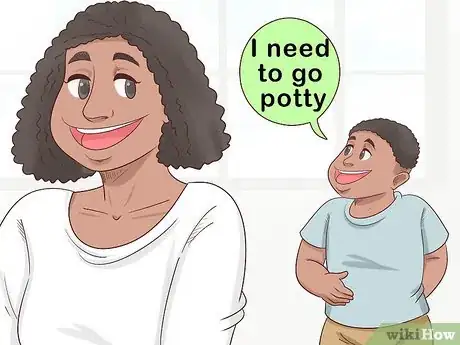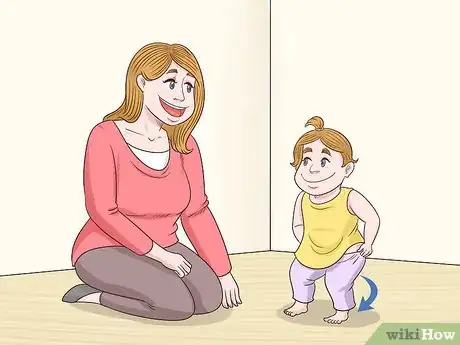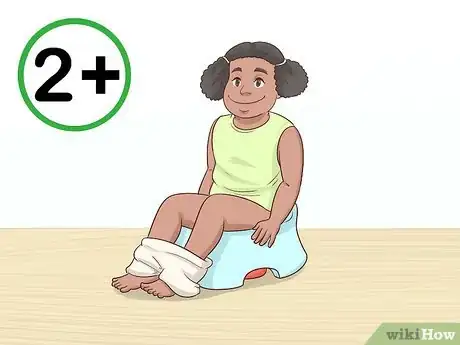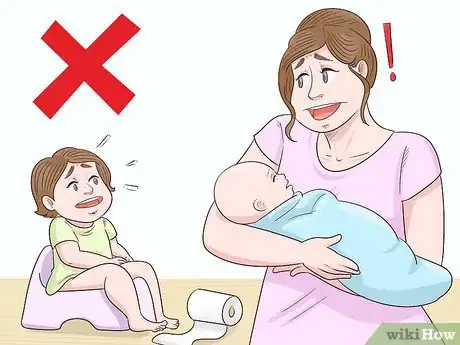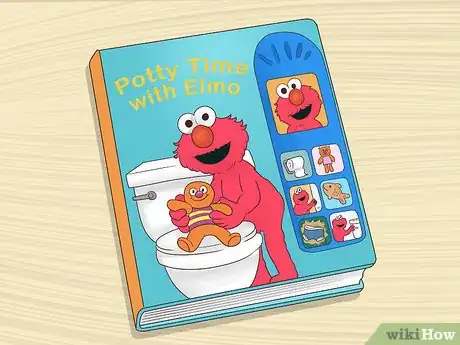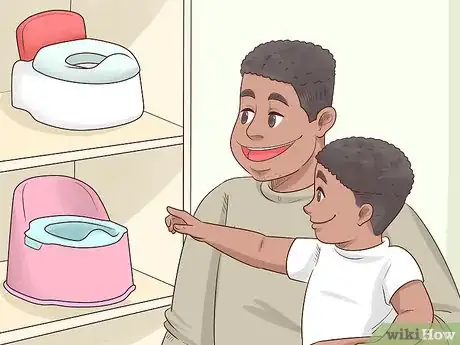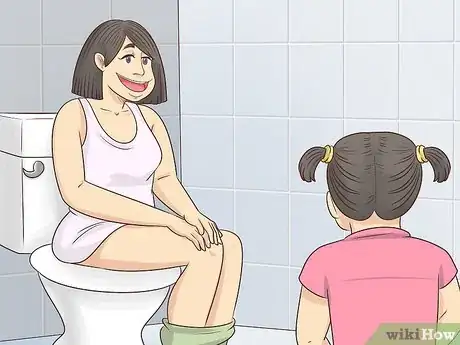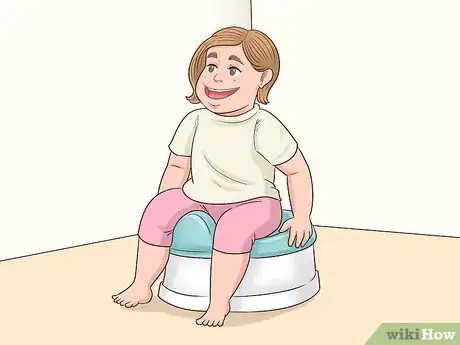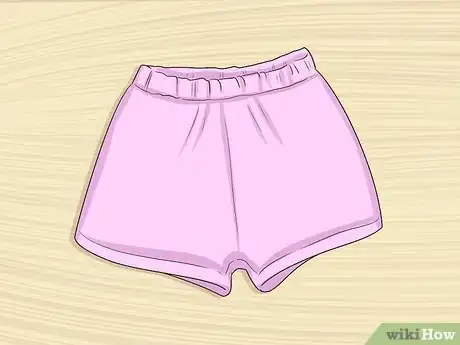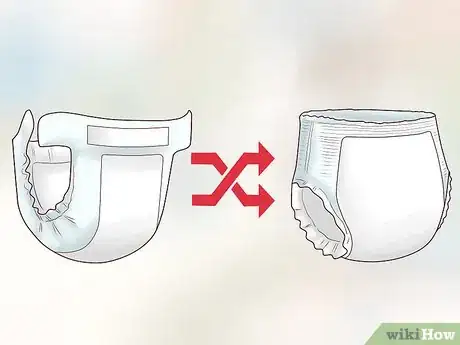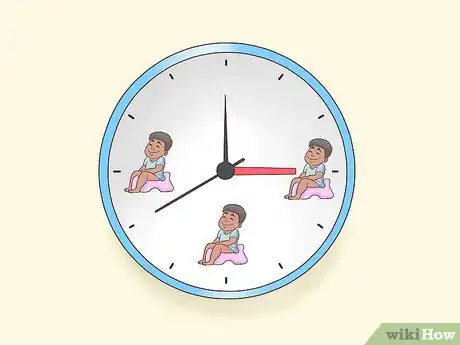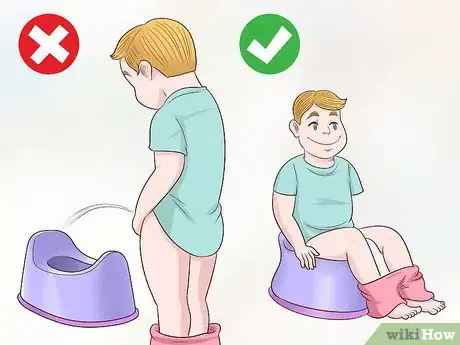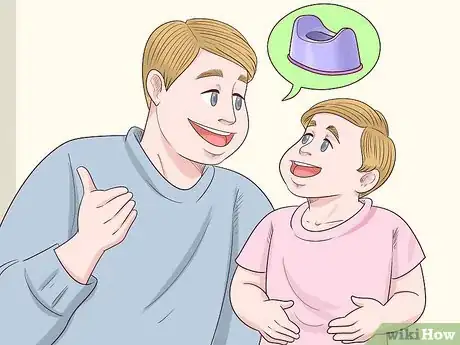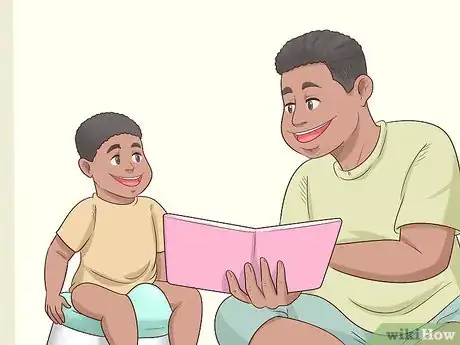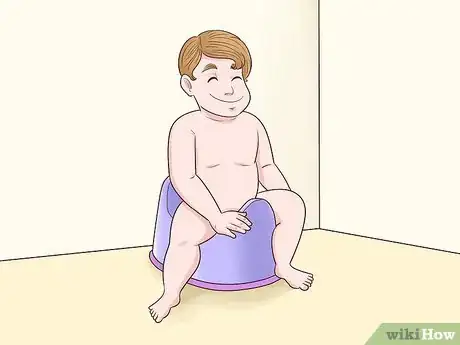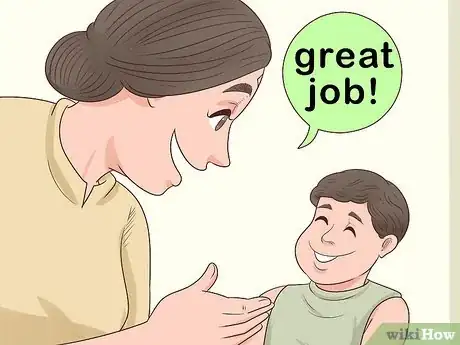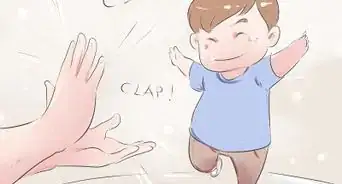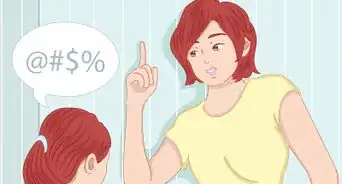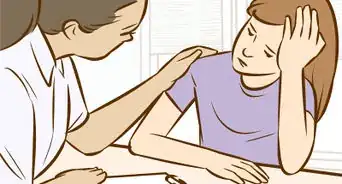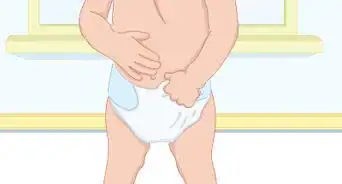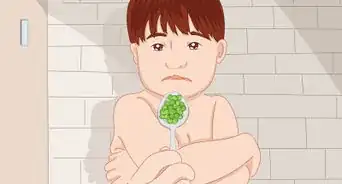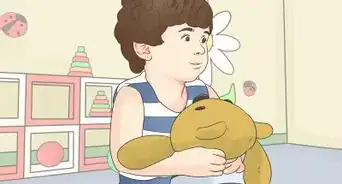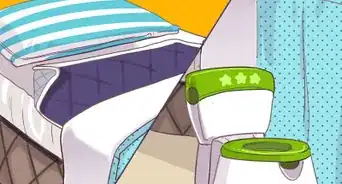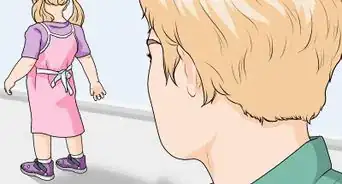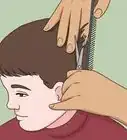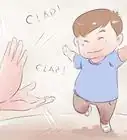This article was co-authored by Sylvia Rath and by wikiHow staff writer, Christopher M. Osborne, PhD. Sylvia Rath is a Parenting Specialist and the Director of Little Village Nursery School in Los Angeles, California. With over 30 years of experience, Sylvia guides parents through the preschool years and beyond by teaching respectful communication and positive discipline methods. Sylvia holds a BA in Psychology and Early Child Development from Antioch University. Before working at Little Village Nursery School, she taught preschool for eight years.
There are 7 references cited in this article, which can be found at the bottom of the page.
This article has been viewed 27,347 times.
Potty training is an exciting milestone for children and parents alike. There are in fact many schools of thought on potty training—some parents try to do it in a week or even a few days, and some start the process with infants.[1] Generally speaking, though, you should look for signs that your toddler is ready and eager to begin potty training, slowly introduce the basics of the process, and plan for ups-and-downs during the weeks or even months it might take until they get the hang of using the potty.
Steps
Recognizing Signs That They’re Ready
-
1Ask yourself if they are interested and motivated. Your child’s eagerness, and not yours, should be your primary guide in determining when your toddler is ready for potty training. If they’re not an eager participant, the process will take longer and be more difficult.[2] [3]
- When you talk about using the potty or mention that their favorite book or TV characters probably use the potty, are they interested or even excited?
-
2Look for signs they recognize the urge to go potty. If they say things like “I need to go potty,” then they’re definitely ready to start training. Or, you might notice that they become more subdued or try to find some privacy in a corner or behind furniture before they relieve themselves.[4]
- Even saying “I don’t need to go potty!” can be a sign that they recognize that they need to go. Focus on building up positive associations with using the potty so they won’t be so resistant.
Advertisement -
3Consider whether they can follow directions like pulling down pants. If they don’t have the communication and motor skills necessary to actually complete the process of using the potty, then it’s usually best to wait before starting training. You want it to be an enjoyable experience for them, not a struggle.[5]
- Proponents of infant potty training rely on reading cues and quickly putting the baby on the potty, and on building hand-signal and simple verbal cues for the process.
-
4Plan to start potty training around age 2-3, especially for girls. Most kids are ready for potty training when they reach 2-3 years of age. Likewise, some kids will be beyond their third birthday before they’re ready. Also, on average, girls tend to be ready to potty train earlier and pick up on it more quickly.[6]
- If your child reaches age 3 and has not shown an interest in or capacity for potty training, consider bringing the issue up with their pediatrician. In most cases there’s nothing wrong and nothing to worry about, but the doctor may be able to provide you with some pointers.[7]
-
5Look for a time when there are fewer other life changes happening. Toddlers thrive with consistency and routine, and potty training is a major disruption to their normal way of doing things. If you combine it with another disruption, like moving, changing jobs, a divorce or new relationship, or a new sibling, the changes may be too great for potty training to be successful.[8]
- However, if they are truly eager and willing to try, don’t delay any more than is absolutely necessary.
Introducing Potty Training
-
1Read books and watch kids' videos on using the potty. Help spur a toddler's interest by reading and watching about using the potty. You can start with these well before they show signs of being ready to start potty training, in order to build a positive view of it beforehand.[9] [10]
- There are many toddler books on the topic of using the potty, and you may be able to find one that stars one of their favorite characters—Elmo, for instance.
- The same holds true for toddler-focused videos. You can probably find at least one with a favorite character—Daniel Tiger, for example—using the potty.
-
2Let them help you choose the potty they’ll use. Kids' potties are available in a variety of different styles and colors. Allowing your child to choose a potty can get them more excited about using it when needed.[11]
- You can try standalone children’s potties, potty seats that fit onto a standard toilet, or both.
- If you do choose a potty seat, also buy a bench so the child’s feet aren’t dangling in the air—this makes evacuating the bowels and bladder easier.
-
3Demonstrate how you use the potty. This may be difficult if you value your privacy while using the bathroom, but toddlers learn by mimicking what they see others doing. Let them watch as you go through the entirety of your toilet routine, explain each step, and answer their questions.[12]
- This works best if you and the child are the same gender, but it’s still worth doing even if that isn’t the case.
- Focus on teaching them how to actually use the potty first, then worry about teaching them to treat it as a private act.
-
4Let them practice the potty sequence fully clothed. Before you begin potty training in earnest, give the toddler a chance to get used to the feeling of sitting on the potty. Place the potty where you’ll use it, read them a book if you plan to do so during the “real deal,” and go through the process of wiping up (over their clothes in this case) and washing their hands (for real in every case).[13]
- Prioritize proper hygiene even during these “dry runs”—make sure they wash their hands with soap and water for at least 20 seconds.
-
5Dress your child in clothing that’s easy to remove. This will allow you or your child to get these clothes out of the way quickly when it’s time to use the potty. Elastic shorts or pants and dresses are good options.[14]
- Avoid dressing your child in onesies, overalls, and other articles of clothing that are too difficult for your child to remove quickly.
- Potty training in warm weather may be a bit easier because kids have fewer layers of clothes on. But don’t wait for summer if your toddler is ready to potty train in winter.
-
6Switch from using diapers to pull-ups if you haven’t done so. Pull-ups function similarly to diapers, but can be pulled up and down just like underpants. This lets your child become more familiar with the normal ritual when they use the restroom.[15]
- Some parents prefer using cloth pull-ups because they think disposable ones are still too much like diapers, and therefore don’t provide enough encouragement for using the potty.
- Keep buying diapers for nighttime, though. Most kids don’t learn to be nighttime potty trained until well after they master it for daytime.
Teaching Them to Use the Potty
-
1Place the potty in the bathroom or another convenient location. If you're using only a potty seat, you'll obviously be potty training in the bathroom. With a toddler potty, though, you can conceivably potty train anywhere in the house. Pick a convenient, accessible spot that's easy to clean, and use it exclusively to help build familiarity and consistency.[16]
- Some parents believe you should potty train only in the bathroom, so you build that association right from the start. Others, though, believe you should potty train in the room that makes the child most comfortable, such as a bedroom or even the living room. Choose the route that makes the most sense for you.
-
2Create a consistent routine for sitting on the potty. Have your child sit on the potty after waking up in the morning, after a nap, and after meals. They’ll have better chances of success in these instances. Alternatively, schedule “potty stops” every few hours during the day where you ask your child to sit on the potty before going back to playing.[17] [18]
- Encourage them to sit for at least a few minutes each time, and praise them for trying whether they actually go potty or not.
- The goal is to turn sitting on the potty into a normal part of their daily activities.
-
3Train boys to sit down to pee first. Focus exclusively on sitting down before teaching them how to pee standing up. This will help prevent confusion in the beginning as your child becomes more familiar with using the potty.[19]
- When a boy seems ready to learn to pee standing up, emphasize the need for him to keep his pants up and backside fully covered. (This will be of utmost importance in school and other public bathrooms.) A father or older brother can help to demonstrate how this is done. If a young boy finds it easier always to pull down his pants, he may continue always using the toilet in a sitting position.
- Consider placing pieces of cereal or candy in the potty when you’re ready to teach a boy how to pee standing up. These items can function like targets boys can aim for!
-
4Encourage them to use the potty whenever you see their cues. Your child may fidget, make straining faces, announce their tummy hurts, look you in the face, hold up their hand, or run off to hide in a corner if they need to use the potty. Take them to the potty immediately upon recognizing these signals, no matter when the next scheduled “potty break” is.[20]
- If you get there and nothing happens, praise them for trying. If it’s too late and they’ve already gone, don’t get flustered. Just keep an eye out for next time.
-
5Read a book or play with a special toy while they sit on the potty. Activities such as these can make potty training seem fun, instead of as a chore or lesson. The longer you can convince them to stay on the potty, the more likely they are to eventually have success.[21]
- Some toddlers might enjoy this potty time with you so much that they don’t want to get off. Whenever possible, let them stay on as long as you can—think of it as a great one-on-one bonding time for the two of you!
-
6Consider allowing your child to go naked or bottomless. This can help children grow more consciously aware of their body signals when it’s really time to use the potty. It’s also impossible for them to ignore or deny what happens when they don’t get on the potty in time.[22] [23]
- This works best if you have an area of your house with easy-to-clean floors and items, or a private backyard they can run around in.
- Ideally they should also hang out in general proximity to the potty so they can get there quickly when needed.
- Signing up for this method of course means accepting that you’ll be cleaning up some messes. However, if you can do it consistently for several days—for instance, during a long weekend when you’re off work—you may find that your toddler is consistently using the potty by the end of the period.
-
7Establish a rewards system for motivation. Children are more likely to use the potty when they know they’re going to be rewarded for doing so. Many parents offer incentives such as pieces of candy, stickers to place on the calendar, or pennies to store in a piggy bank.[24]
- What one parent sees as “rewarding” another might see as “bribery,” so you’ll have to decide what role motivational items should play in potty training your child.
- If you do offer rewards, try to keep it consistent among caregivers. You don’t want one person offering an M&M and the other a dollar!
-
8Praise your child when they successfully use the potty. Being positive and recognizing your child’s accomplishment will motivate them to continue using the potty. Say something like “You did a great job going potty—I’m so proud of you!”[25]
- Praise them just for trying as well: “Thank you for trying to go potty—maybe next time we’ll get to flush something away!”
- Never respond negatively or punish the child for not using the potty or for having an accident. You’ll just create negative associations with using the potty.
Expert Q&A
-
QuestionHow long will it take before my child is potty trained?
 Sylvia RathSylvia Rath is a Parenting Specialist and the Director of Little Village Nursery School in Los Angeles, California. With over 30 years of experience, Sylvia guides parents through the preschool years and beyond by teaching respectful communication and positive discipline methods. Sylvia holds a BA in Psychology and Early Child Development from Antioch University. Before working at Little Village Nursery School, she taught preschool for eight years.
Sylvia RathSylvia Rath is a Parenting Specialist and the Director of Little Village Nursery School in Los Angeles, California. With over 30 years of experience, Sylvia guides parents through the preschool years and beyond by teaching respectful communication and positive discipline methods. Sylvia holds a BA in Psychology and Early Child Development from Antioch University. Before working at Little Village Nursery School, she taught preschool for eight years.
Parenting Specialist It usually takes a couple of weeks for daytime potty training, and nighttime potty training is another step. Reduce liquids at nighttime to help the process along!
It usually takes a couple of weeks for daytime potty training, and nighttime potty training is another step. Reduce liquids at nighttime to help the process along! -
QuestionWhat should I do if my child is refusing to potty train?
 Sylvia RathSylvia Rath is a Parenting Specialist and the Director of Little Village Nursery School in Los Angeles, California. With over 30 years of experience, Sylvia guides parents through the preschool years and beyond by teaching respectful communication and positive discipline methods. Sylvia holds a BA in Psychology and Early Child Development from Antioch University. Before working at Little Village Nursery School, she taught preschool for eight years.
Sylvia RathSylvia Rath is a Parenting Specialist and the Director of Little Village Nursery School in Los Angeles, California. With over 30 years of experience, Sylvia guides parents through the preschool years and beyond by teaching respectful communication and positive discipline methods. Sylvia holds a BA in Psychology and Early Child Development from Antioch University. Before working at Little Village Nursery School, she taught preschool for eight years.
Parenting Specialist If potty training becomes a battle, stop and take a pause. No one can make anyone eat or poop, so there's no need for a power struggle over this.
If potty training becomes a battle, stop and take a pause. No one can make anyone eat or poop, so there's no need for a power struggle over this. -
QuestionHow exactly do I teach a boy to point his penis?
 Audrée AdamCommunity AnswerWhen you potty train your boy, you should start by making him sit on the toilet. His fine motor skills aren't well developed and holding his penis might be very hard to do while he is urinating. When he asks to urinate while standing or when he is able to say when he needs to go to the toilet, you might have a little stool for him to stand on and have him hold his penis while urinating. It may be messy at first, but he will get better at it with enough time and encouragement.
Audrée AdamCommunity AnswerWhen you potty train your boy, you should start by making him sit on the toilet. His fine motor skills aren't well developed and holding his penis might be very hard to do while he is urinating. When he asks to urinate while standing or when he is able to say when he needs to go to the toilet, you might have a little stool for him to stand on and have him hold his penis while urinating. It may be messy at first, but he will get better at it with enough time and encouragement.
Warnings
- Refrain from scolding your children if they wet themselves without informing you they needed to use the potty. This negative behavior may cause children to associate potty training with being in trouble, and could result in setbacks with potty training.⧼thumbs_response⧽
References
- ↑ https://www.parenting.com/gallery/how-to-potty-train
- ↑ Sylvia Rath. Parenting Specialist. Expert Interview. 18 May 2021.
- ↑ https://www.mayoclinic.org/healthy-lifestyle/infant-and-toddler-health/in-depth/potty-training/art-20045230
- ↑ https://www.mayoclinic.org/healthy-lifestyle/infant-and-toddler-health/in-depth/potty-training/art-20045230
- ↑ https://www.mayoclinic.org/healthy-lifestyle/infant-and-toddler-health/in-depth/potty-training/art-20045230
- ↑ https://www.mayoclinic.org/healthy-lifestyle/infant-and-toddler-health/in-depth/potty-training/art-20045230
- ↑ https://kidshealth.org/en/parents/toilet-teaching.html
- ↑ https://kidshealth.org/en/parents/toilet-teaching.html
- ↑ Sylvia Rath. Parenting Specialist. Expert Interview. 18 May 2021.
- ↑ https://www.parents.com/toddlers-preschoolers/potty-training/basics/step-by-step-guide-to-potty-training/
- ↑ https://www.babycenter.com/0_the-abcs-of-potty-training_4399.bc
- ↑ https://www.whattoexpect.com/toddler/potty-training/how-to-start-potty-training/
- ↑ https://www.parents.com/toddlers-preschoolers/potty-training/basics/step-by-step-guide-to-potty-training/
- ↑ https://kidshealth.org/en/parents/toilet-teaching.html
- ↑ https://kidshealth.org/en/parents/toilet-teaching.html
- ↑ https://kidshealth.org/en/parents/toilet-teaching.html
- ↑ Sylvia Rath. Parenting Specialist. Expert Interview. 18 May 2021.
- ↑ https://kidshealth.org/en/parents/toilet-teaching.html
- ↑ https://kidshealth.org/en/parents/toilet-teaching.html
- ↑ https://www.mayoclinic.org/healthy-lifestyle/infant-and-toddler-health/in-depth/potty-training/art-20045230
- ↑ https://kidshealth.org/en/parents/toilet-teaching.html
- ↑ Sylvia Rath. Parenting Specialist. Expert Interview. 18 May 2021.
- ↑ https://www.whattoexpect.com/toddler/potty-training/how-to-start-potty-training/
- ↑ https://kidshealth.org/en/parents/toilet-teaching.html
- ↑ https://www.mayoclinic.org/healthy-lifestyle/infant-and-toddler-health/in-depth/potty-training/art-20045230
About This Article
Every child develops differently, so it’s important to make sure your child is ready before you start the potty-training process. Check for signs that your child is interested, such as excitement when reading books or watching videos about using the potty. Your child may also be ready if they show signs that they can recognize when they need to go. For example, they might say, “I need to pee-pee,” or “I have to go potty.” While the right age for potty training depends on your child, many kids are ready by the time they are 2 or 3 years old. When you’re ready to start the potty-training process, introduce the idea to your child by reading books about potty training with them. You can also help them feel more interested and involved by letting them pick out their own potty at the store. Demonstrate how to use the potty by showing them how you use the toilet, and allow them to practice by sitting on the potty with their diaper on. For tips on how to create a consistent potty-training routine, read on!


